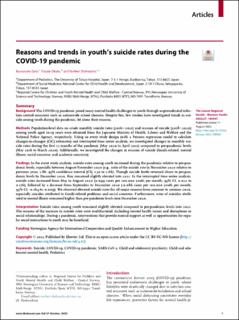| dc.description.abstract | Background The COVID-19 pandemic posed many mental health challenges to youth through unprecedented infection control measures such as nationwide school closures. Despite this, few studies have investigated trends in suicide among youth during the pandemic, let alone their reasons. Methods Population-level data on crude monthly suicide rates (2016–2021) and reasons of suicide (2018–2020) among youth aged 10-19 years were obtained from the Japanese Ministry of Health, Labour and Welfare and the National Police Agency, respectively. Using an event study design (with a Poisson regression model to calculate changes-in-changes (CiC) estimates) and interrupted time series analysis, we investigated changes in monthly suicide rates during the first 12 months of the pandemic (May 2020 to April 2021) compared to pre-pandemic levels (May 2016 to March 2020). Additionally, we investigated the changes in reasons of suicide (family-related, mental illness, social concerns, and academic concerns). Findings In the event study analysis, suicide rates among youth increased during the pandemic relative to pre-pandemic levels, especially between August-November 2020 (e.g., ratio of the suicide rate in November 2020 relative to previous years, 1.86; 95% confidence interval (CI), 1.30 to 2.66). Though suicide levels returned closer to pre-pandemic levels by December 2020, they remained slightly elevated into 2021. In the interrupted time series analysis, suicide rates increased from May to August 2020 (0.099 cases per 100,000 youth per month; 95% CI, 0.022 to 0.176), followed by a decrease from September to December 2020 (-0.086 cases per 100,000 youth per month; 95% CI, -0.164 to -0.009). We observed elevated suicide rates for all major reasons from summer to autumn 2020, especially suicides attributed to family-related problems and social concerns. Furthermore, rates of suicides attributed to mental illness remained higher than pre-pandemic levels into December 2020. Interpretation Suicide rates among youth remained slightly elevated compared to pre-pandemic levels into 2021. The reasons of the increase in suicide rates were multifactorial, including mental health issues and disruptions in social relationships. During a pandemic, interventions that provide mental support as well as opportunities for regular social interactions to youth may be beneficial. | en_US |

